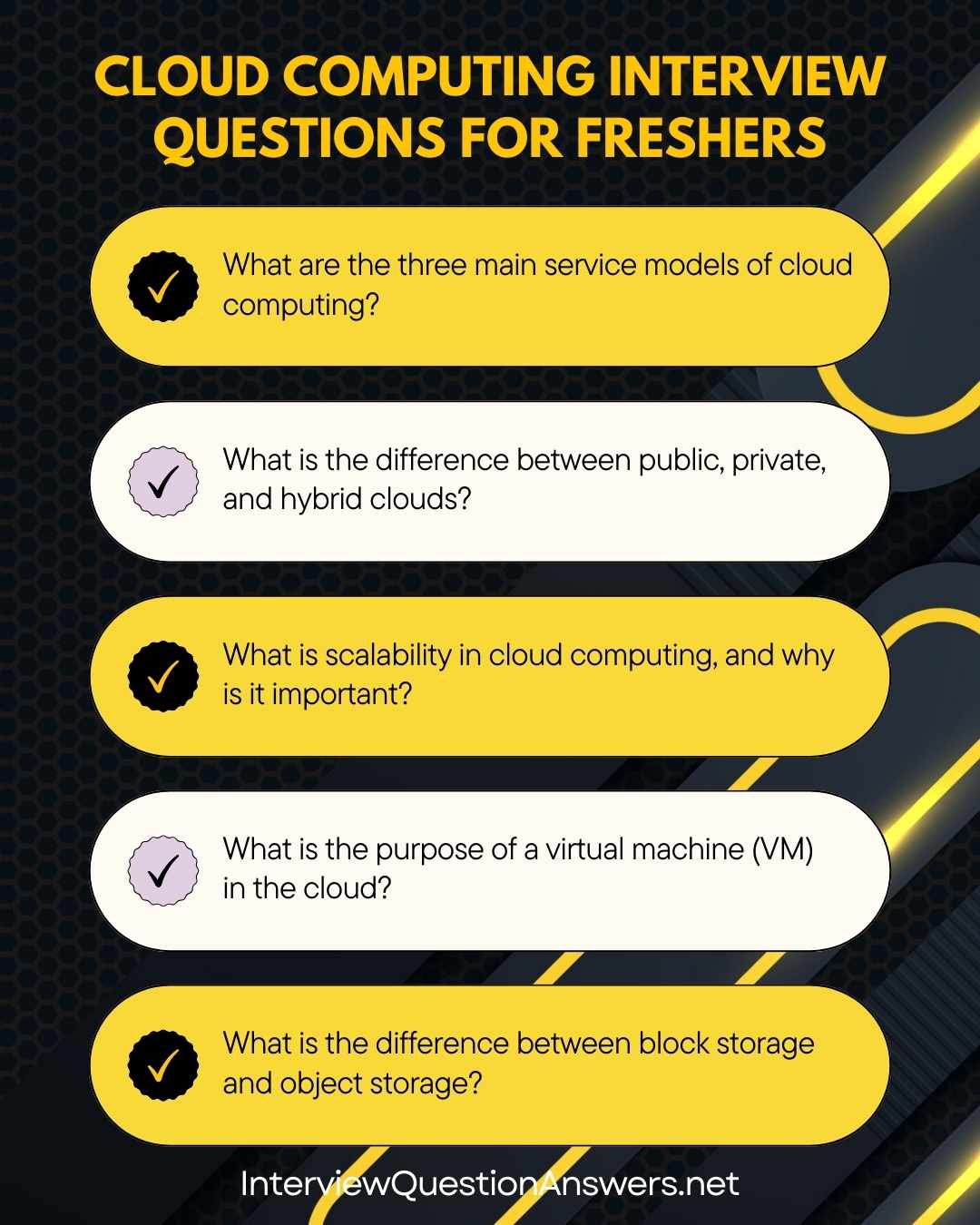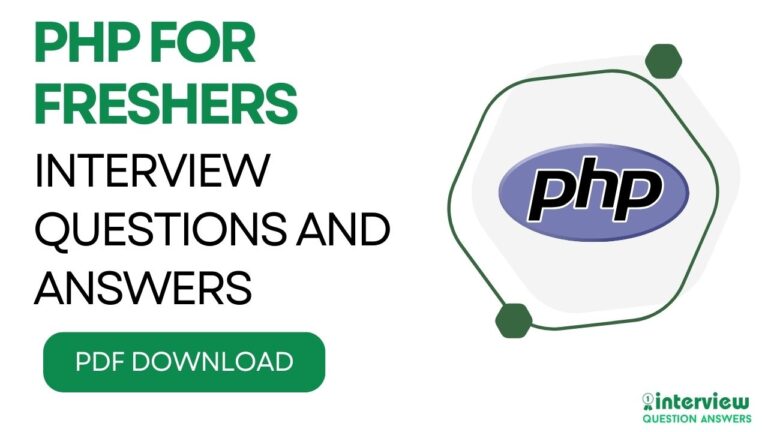Top 60 Cloud Computing Interview Questions for Freshers
This Cloud Computing Interview Questions for Freshers guide provides a detailed list of basic and beginner-friendly questions. These questions are designed to help you grasp the fundamental concepts of cloud technology and answer interview questions with confidence.
This guide covers essential cloud computing topics, including cloud service models (IaaS, PaaS, SaaS), deployment models (Public, Private, Hybrid), virtualization, cloud storage, and security basics. It also introduces you to leading cloud platforms such as AWS, Microsoft Azure, and Google Cloud.
As cloud adoption continues to grow across industries, there is an increasing demand for professionals with cloud computing skills, DevOps knowledge, and security expertise. Freshers who have a strong foundation in cloud fundamentals, scalability, and cost optimization are highly valued in the job market. Whether you aspire to become a cloud engineer, DevOps professional, or solution architect, this guide serves as an ideal starting point for your interview preparation.
You can also explore: Cloud Computing Interview Questions and Answers PDF
Table of Contents
Entry Level Cloud Computing Interview Questions
Que 1. What is cloud computing, and what are its main benefits?
Answer:
Cloud computing delivers computing services like servers, storage, and applications over the internet. Benefits include scalability, cost-efficiency (pay-as-you-go), flexibility, and reduced maintenance overhead.
Que 2. What are the three main service models of cloud computing?
Answer:
The three main service models are:
- IaaS (Infrastructure as a Service): Provides virtualized infrastructure
- PaaS (Platform as a Service): Offers platforms for development
- SaaS (Software as a Service): Delivers software over the internet
Que 3. What is the difference between public, private, and hybrid clouds?
Answer:
- Public Cloud: Services hosted by third-party providers (e.g., AWS, Azure).
- Private Cloud: Dedicated infrastructure for one organization, on-premises or hosted.
- Hybrid Cloud: Combines public and private clouds for flexibility and data control.
Que 4. What is virtualization in cloud computing?
Answer:
Virtualization creates virtual versions of resources like servers or storage, enabling multiple operating systems to run on a single physical machine, improving resource utilization.
Que 5. What is an API in the context of cloud computing?
Answer:
An API (Application Programming Interface) allows cloud services to interact programmatically. For example, AWS APIs enable automation of resource management.
aws ec2 describe-instances --region us-east-1Que 6. What is the role of a cloud provider?
Answer:
A cloud provider offers infrastructure, platforms, or software as services, managing hardware, security, and scalability. Examples include AWS, Microsoft Azure, and Google Cloud Platform (GCP).
Que 7. What is scalability in cloud computing, and why is it important?
Answer:
Scalability is the ability to increase or decrease resources based on demand. It ensures cost-efficiency and performance during traffic spikes, like scaling EC2 instances in AWS.
Que 8. What is the purpose of a virtual machine (VM) in the cloud?
Answer:
A VM emulates a physical computer, running an operating system and applications. In the cloud, VMs (e.g., AWS EC2 instances) provide isolated environments for workloads.
Que 9. How does cloud storage work, and what are some examples?
Answer:
Cloud storage stores data on remote servers, accessible via the internet. Examples include Amazon S3, Google Cloud Storage, and Azure Blob Storage, offering durability and scalability.
Que 10. What is the difference between block storage and object storage?
Answer:
- Block Storage: Divides data into fixed-size blocks, ideal for databases (e.g., AWS EBS).
- Object Storage: Stores data as objects with metadata, suited for unstructured data (e.g., AWS S3).
Que 11. What is a cloud region, and why does it matter?
Answer:
A cloud region is a geographic area with data centers hosting cloud services. Choosing a region impacts latency, compliance, and availability (e.g., AWS us-east-1).
Que 12. What is the purpose of load balancing in the cloud?
Answer:
Load balancing distributes traffic across multiple servers to ensure availability and performance. For example, AWS Elastic Load Balancer (ELB) routes requests to healthy EC2 instances.
Que 13. What is a container, and how does it differ from a virtual machine?
Answer:
A container virtualizes an OS, sharing the host’s kernel, making it lightweight compared to VMs, which include full OS copies. Containers (e.g., Docker) are used in cloud platforms like AWS ECS.
Que 14. What is AWS S3, and what are its common use cases?
Answer:
Amazon S3 (Simple Storage Service) is an object storage service for storing and retrieving data. Use cases include backups, static website hosting, and big data storage.
<!-- S3-hosted static website -->
<img src="https://my-bucket.s3.amazonaws.com/image.jpg">Que 15. How do you ensure data security in the cloud?
Answer:
Use encryption (at rest and in transit), IAM (Identity and Access Management) policies, and regular audits. For example, AWS KMS encrypts S3 data, and IAM restricts access.
Que 16. What is the purpose of a content delivery network (CDN) in cloud computing?
Answer:
A CDN (e.g., AWS CloudFront) caches content closer to users, reducing latency and improving load times for web assets like images and videos.
Que 17. What is auto-scaling in the cloud, and how does it work?
Answer:
Auto-scaling automatically adjusts resources based on demand, using metrics like CPU usage. For example, AWS Auto Scaling adds or removes EC2 instances to handle traffic spikes.
# AWS Auto Scaling policy
AutoScalingGroup:
MinSize: 2
MaxSize: 10
DesiredCapacity: 4Que 18. What is a serverless architecture, and what are its benefits?
Answer:
Serverless architecture (e.g., AWS Lambda) runs code without managing servers. Benefits include automatic scaling, reduced costs, and simplified deployment.
// AWS Lambda function
exports.handler = async (event) => {
return { statusCode: 200, body: JSON.stringify('Hello from Lambda!') };
};Que 19. What is the role of IAM in cloud security?
Answer:
IAM (Identity and Access Management) controls access to cloud resources by defining users, roles, and permissions. For example, AWS IAM restricts who can access S3 buckets.
{
"Effect": "Allow",
"Action": "s3:GetObject",
"Resource": "arn:aws:s3:::my-bucket/*"
}Que 20. How do you monitor cloud resources, and what tools are commonly used?
Answer:
Monitor resources using tools like AWS CloudWatch, Azure Monitor, or GCP Operations Suite to track metrics, logs, and alerts for performance and issues.
# AWS CloudWatch CLI example
aws cloudwatch put-metric-data --metric-name CPUUtilization --namespace MyApp --value 75
Also Check: Cloud Computing Interview Questions for Experienced Professionals
Most Common Cloud Computing Interview Questions for Freshers
Que 21. What is the difference between scalability and elasticity in cloud computing?
Answer:
Scalability is the ability to handle increased workloads by adding resources, either vertically (more power) or horizontally (more instances). Elasticity is the ability to automatically scale resources up or down based on demand, ensuring cost-efficiency. For example, AWS Auto Scaling provides elasticity by adjusting EC2 instances dynamically.
Que 22. What is a cloud service provider, and can you name a few?
Answer:
A cloud service provider offers computing resources like servers, storage, and applications over the internet. Examples include Amazon Web Services (AWS), Microsoft Azure, Google Cloud Platform (GCP), and IBM Cloud.
Que 23. What is the purpose of a virtual private cloud (VPC)?
Answer:
A VPC is an isolated network within a public cloud, allowing users to define their own IP ranges, subnets, and security settings. For example, AWS VPC ensures private, secure communication between resources.
# AWS VPC configuration
VPC:
Type: AWS::EC2::VPC
Properties:
CidrBlock: 10.0.0.0/16Que 24. How does cloud computing improve disaster recovery?
Answer:
Cloud computing enhances disaster recovery by offering off-site backups, automated replication, and quick recovery options. Services like AWS S3 or Azure Backup store data redundantly across regions, ensuring data availability.
Que 25. What is the role of load balancing in cloud environments?
Answer:
Load balancing distributes incoming traffic across multiple servers to ensure high availability and performance. For example, AWS Elastic Load Balancer (ELB) routes requests to healthy EC2 instances.
# AWS ELB configuration
LoadBalancer:
Type: AWS::ElasticLoadBalancingV2::LoadBalancer
Properties:
Subnets: [subnet-1, subnet-2]Que 26. What is serverless computing, and how does it work?
Answer:
Serverless computing allows developers to run code without managing servers. The cloud provider handles scaling and infrastructure. For example, AWS Lambda executes functions in response to events like HTTP requests.
// AWS Lambda function
exports.handler = async (event) => {
return { statusCode: 200, body: JSON.stringify('Hello, World!') };
};Que 27. What is the difference between IaaS, PaaS, and SaaS?
Answer:
- IaaS: Provides infrastructure like servers (e.g., AWS EC2).
- PaaS: Offers platforms for app development (e.g., Google App Engine).
- SaaS: Delivers fully managed software (e.g., Google Docs).
Que 28. How does cloud storage ensure data durability?
Answer:
Cloud storage ensures durability through data replication across multiple data centers and regions. For example, AWS S3 guarantees 99.999999999% durability by storing objects redundantly.
Que 29. What is a cloud region, and why is it important?
Answer:
A cloud region is a geographic area with one or more data centers hosting cloud services. It impacts latency, compliance, and availability. For example, choosing AWS us-east-1 reduces latency for U.S. users.
Que 30. What is the purpose of Identity and Access Management (IAM) in the cloud?
Answer:
IAM controls access to cloud resources by defining users, roles, and permissions. For example, AWS IAM restricts access to specific S3 buckets or EC2 instances.
{
"Effect": "Allow",
"Action": "s3:PutObject",
"Resource": "arn:aws:s3:::my-bucket/*"
}Que 31. How do you monitor cloud resources?
Answer:
Use monitoring tools like AWS CloudWatch, Azure Monitor, or GCP Operations Suite to track metrics (e.g., CPU usage), logs, and set alerts for anomalies.
# AWS CloudWatch metric example
aws cloudwatch put-metric-data --metric-name Errors --namespace MyApp --value 5Que 32. What is a content delivery network (CDN), and how does it work in the cloud?
Answer:
A CDN caches content at edge locations to reduce latency. For example, AWS CloudFront delivers cached web assets like images closer to users, improving load times.
Que 33. What is the difference between block storage and object storage?
Answer:
- Block Storage: Stores data in fixed-size blocks, ideal for databases (e.g., AWS EBS).
- Object Storage: Stores data as objects with metadata, suited for unstructured data (e.g., AWS S3).
Que 34. How does auto-scaling work in the cloud?
Answer:
Auto-scaling adjusts resources based on demand, using metrics like CPU or traffic. For example, AWS Auto Scaling adds/removes EC2 instances based on predefined policies.
# AWS Auto Scaling policy
AutoScalingGroup:
MinSize: 1
MaxSize: 5
ScalingPolicies:
- TargetTrackingConfiguration:
TargetValue: 70.0
PredefinedMetricSpecification:
PredefinedMetricType: ASGAverageCPUUtilizationQue 35. What is a container, and how is it used in the cloud?
Answer:
A container is a lightweight, portable unit that packages code and dependencies. In the cloud, containers (e.g., Docker) run on services like AWS ECS or Kubernetes for consistent deployments.
Que 36. What is the role of encryption in cloud security?
Answer:
Encryption protects data at rest (e.g., AWS S3 with KMS) and in transit (e.g., HTTPS/TLS). It ensures confidentiality and compliance with regulations like GDPR.
Que 37. What is the purpose of a cloud formation template?
Answer:
A cloud formation template (e.g., AWS CloudFormation) defines infrastructure as code, automating resource provisioning like EC2 instances or S3 buckets.
# CloudFormation template
Resources:
MyBucket:
Type: AWS::S3::Bucket
Properties:
BucketName: my-bucketQue 38. How do you ensure high availability in a cloud environment?
Answer:
Deploy resources across multiple availability zones, use load balancers, and replicate data. For example, AWS RDS Multi-AZ ensures database failover for high availability.
Que 39. What is the difference between a cloud database and a traditional database?
Answer:
A cloud database (e.g., AWS RDS, Azure SQL) is managed by the cloud provider, offering scalability, backups, and high availability. Traditional databases require manual management of hardware and scaling.
Que 40. What are the advantages of using a cloud-based CI/CD pipeline?
Answer:
Cloud-based CI/CD pipelines (e.g., AWS CodePipeline, GitHub Actions) automate testing and deployment, scale with demand, reduce infrastructure costs, and integrate with cloud services for seamless workflows.
# GitHub Actions workflow
name: CI
on: [push]
jobs:
build:
runs-on: ubuntu-latest
steps:
- uses: actions/checkout@v3
- run: npm testAdvanced Cloud Computing Interview Questions for Freshers
Que 41. How do you implement serverless architecture in a cloud application, and what are its challenges?
Answer:
Use serverless services like AWS Lambda, Azure Functions, or Google Cloud Functions to run code without managing servers. Challenges include cold start latency, debugging complexity, and vendor lock-in. Mitigate with warm-up strategies and modular code.
// AWS Lambda function
exports.handler = async (event) => {
const response = { statusCode: 200, body: JSON.stringify('Hello from Lambda!') };
return response;
};Que 42. What is Infrastructure as Code (IaC), and how do you use it in the cloud?
Answer:
IaC manages infrastructure through code, enabling automation and consistency. Tools like AWS CloudFormation or Terraform define resources declaratively. For example, a CloudFormation template provisions an S3 bucket.
# CloudFormation template
Resources:
MyBucket:
Type: AWS::S3::Bucket
Properties:
BucketName: my-unique-bucketQue 43. How do you secure data in transit and at rest in a cloud environment?
Answer:
Encrypt data in transit with TLS/HTTPS and at rest with services like AWS KMS or Azure Key Vault. Use IAM policies to restrict access and enable server-side encryption for storage services like S3.
{
"Effect": "Allow",
"Action": "kms:Decrypt",
"Resource": "arn:aws:kms:us-east-1:123456789012:key/*"
}Que 44. How do you implement auto-scaling for a cloud application?
Answer:
Use services like AWS Auto Scaling or Azure Scale Sets to adjust resources based on metrics (e.g., CPU usage). Define policies to add/remove instances dynamically, ensuring cost-efficiency and performance.
# AWS Auto Scaling policy
AutoScalingGroup:
Type: AWS::AutoScaling::AutoScalingGroup
Properties:
MinSize: 2
MaxSize: 10
TargetGroupARNs: [ref: MyTargetGroup]
ScalingPolicies:
- Type: TargetTrackingScaling
TargetTrackingConfiguration:
TargetValue: 70.0
PredefinedMetricSpecification:
PredefinedMetricType: ASGAverageCPUUtilizationQue 45. What is a container orchestration platform, and how does it work in the cloud?
Answer:
Container orchestration platforms like Kubernetes or AWS ECS manage container deployment, scaling, and networking. They automate tasks like load balancing and failover, using tools like kubectl for configuration.
# Kubernetes deployment
apiVersion: apps/v1
kind: Deployment
metadata:
name: my-app
spec:
replicas: 3
template:
spec:
containers:
- name: my-app
image: my-app:latestQue 46. How do you monitor and log cloud application performance?
Answer:
Use tools like AWS CloudWatch, Azure Monitor, or GCP Operations Suite to track metrics (e.g., latency), set alarms, and aggregate logs. Integrate with log management tools like ELK Stack for analysis.
# AWS CloudWatch log example
aws cloudwatch put-metric-data --metric-name Latency --namespace MyApp --value 120Que 47. How do you ensure high availability in a cloud architecture?
Answer:
Deploy across multiple availability zones, use load balancers (e.g., AWS ELB), and replicate data with services like AWS RDS Multi-AZ. Implement health checks to reroute traffic from failed instances.
# AWS ELB health check
LoadBalancer:
Type: AWS::ElasticLoadBalancingV2::LoadBalancer
Properties:
HealthCheckPath: /healthQue 48. What is a content delivery network (CDN), and how do you configure it in the cloud?
Answer:
A CDN (e.g., AWS CloudFront, Azure CDN) caches content at edge locations to reduce latency. Configure it to distribute static assets like images or scripts, setting origin servers and caching policies.
# CloudFront distribution
Distribution:
Type: AWS::CloudFront::Distribution
Properties:
DistributionConfig:
Origins:
- DomainName: my-bucket.s3.amazonaws.com
Enabled: trueQue 49. How do you implement a CI/CD pipeline in the cloud?
Answer:
Use tools like AWS CodePipeline, Azure DevOps, or GitHub Actions to automate code testing, building, and deployment. Integrate with cloud services for seamless delivery to environments like ECS or Lambda.
# GitHub Actions workflow
name: Deploy
on: [push]
jobs:
deploy:
runs-on: ubuntu-latest
steps:
- uses: actions/checkout@v3
- run: aws s3 sync . s3://my-bucketQue 50. What is the role of a cloud-native database, and how does it differ from traditional databases?
Answer:
Cloud-native databases (e.g., AWS DynamoDB, Azure Cosmos DB) are fully managed, scalable, and optimized for cloud environments. Unlike traditional databases, they offer automatic scaling, global replication, and serverless options.
// DynamoDB example
const AWS = require('aws-sdk');
const dynamoDB = new AWS.DynamoDB.DocumentClient();
dynamoDB.put({ TableName: 'Users', Item: { id: '1', name: 'John' } }).promise();Que 51. How do you handle multi-region deployments in the cloud?
Answer:
Deploy resources across multiple regions using tools like AWS Route 53 for DNS routing. Replicate data with services like S3 Cross-Region Replication and monitor latency with CloudWatch.
# Route 53 latency-based routing
HostedZone:
Type: AWS::Route53::RecordSet
Properties:
Type: A
LatencyRoutingPolicy:
Region: us-east-1Que 52. How do you manage costs in a cloud environment?
Answer:
Use cost management tools like AWS Cost Explorer or Azure Cost Management. Optimize by right-sizing instances, using reserved instances, and enabling auto-scaling to avoid over-provisioning.
Que 53. What is a cloud access security broker (CASB), and how is it used?
Answer:
A CASB monitors and secures cloud services, enforcing policies for data protection and compliance. It integrates with cloud providers to control access and detect threats.
Que 54. How do you implement disaster recovery in the cloud?
Answer:
Use services like AWS Backup or Azure Site Recovery to automate backups and failover. Store data in multiple regions and test recovery plans regularly.
# AWS Backup plan
BackupPlan:
Type: AWS::Backup::BackupPlan
Properties:
BackupPlan:
BackupPlanName: MyBackupPlan
Rules:
- RuleName: Daily
ScheduleExpression: cron(0 5 * * ? *)Que 55. How do you secure API endpoints in the cloud?
Answer:
Use API gateways (e.g., AWS API Gateway) with authentication (e.g., JWT, OAuth), rate limiting, and CORS policies. Encrypt traffic with TLS and validate inputs.
# API Gateway configuration
RestApi:
Type: AWS::ApiGateway::RestApi
Properties:
Name: MyApi
EndpointConfiguration:
Types: [REGIONAL]Que 56. How do you use serverless databases in the cloud?
Answer:
Use serverless databases like AWS Aurora Serverless or Azure Cosmos DB for automatic scaling and maintenance. Query data via APIs or SDKs, optimizing for dynamic workloads.
// Aurora Serverless example
const mysql = require('mysql2/promise');
const connection = await mysql.createConnection({
host: 'aurora-endpoint',
user: 'admin',
database: 'mydb'
});Que 57. How do you implement event-driven architecture in the cloud?
Answer:
Use services like AWS EventBridge or Azure Event Grid to trigger actions based on events. For example, an S3 upload can trigger a Lambda function for processing.
# EventBridge rule
Rule:
Type: AWS::Events::Rule
Properties:
EventPattern:
source: ["aws.s3"]
Targets:
- Arn: !GetAtt MyLambdaFunction.ArnQue 58. How do you handle data migration to the cloud?
Answer:
Use tools like AWS Database Migration Service (DMS) or Azure Data Factory to migrate data. Plan schema compatibility, minimize downtime, and validate data post-migration.
Que 59. What is the role of a cloud load balancer, and how do you configure it?
Answer:
A cloud load balancer (e.g., AWS ELB, Azure Load Balancer) distributes traffic across instances for high availability. Configure health checks and routing rules to ensure reliability.
# AWS ALB configuration
LoadBalancer:
Type: AWS::ElasticLoadBalancingV2::LoadBalancer
Properties:
Subnets: [subnet-1, subnet-2]
Type: applicationQue 60. How do you integrate cloud services with CI/CD pipelines?
Answer:
Use cloud-native CI/CD tools like AWS CodePipeline or Azure DevOps to automate testing, building, and deployment. Integrate with services like ECS, Lambda, or S3 for seamless delivery.
# AWS CodePipeline
Pipeline:
Type: AWS::CodePipeline::Pipeline
Properties:
Stages:
- Name: Source
Actions:
- Name: SourceAction
ActionTypeId:
Category: Source
Provider: CodeCommitConclusion
As cloud computing trends like serverless computing, containerization, AI integrations, and multi-cloud strategies reshape the IT industry, freshers who stay updated on emerging cloud services, security practices, and real-world cloud applications will have a clear advantage in building successful cloud careers.
We have already shared the questions for Cloud Computing Interview Questions for Freshers, covering basic concepts, beginner-level scenario questions, and essential cloud fundamentals to help you prepare effectively. This Cloud Computing Interview Questions for Freshers Guide equips you with the knowledge required to build a strong foundation in cloud technology and confidently face interviews.
Similar Guides:













